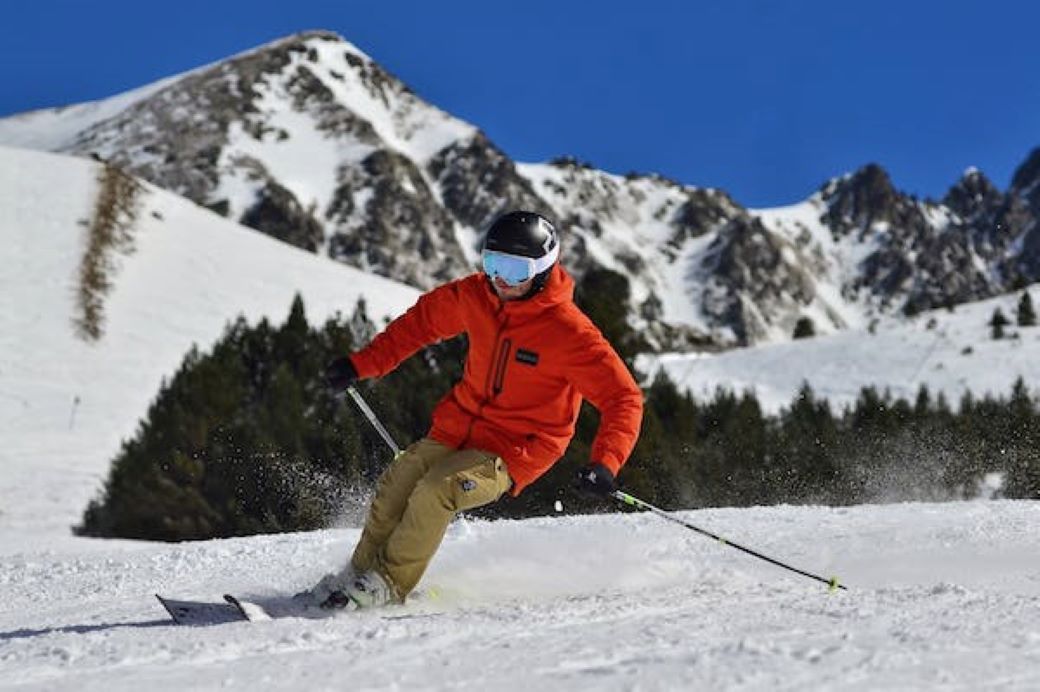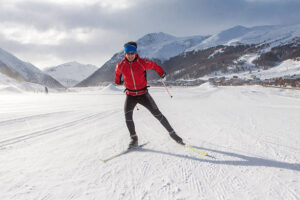Skiing is a popular winter sport that offers a fun and exciting way to stay active and burn calories. Whether you’re a beginner or an experienced skier, skiing is a great way to improve cardiovascular fitness, build muscle strength, and keep fit.
In this article, we will take a closer look at the number of calories burned during skiing, as well as the factors that can affect calorie burn so you can try to maximize it during every ski trip.

The Science of Calorie Burn
Calories burned during skiing can vary greatly depending on the intensity of the activity, the duration of the activity, and taking into consideration of the skier’s weight and body composition.
 Basically, the more effort that you can exert on your ski runs, the more calories you will burn. Unfortunately, if you are older, you probably won’t be able to exert yourself compared to someone who is half your age. Our metabolism also starts slowing down as we age and we tend not to push ourselves as hard.
Basically, the more effort that you can exert on your ski runs, the more calories you will burn. Unfortunately, if you are older, you probably won’t be able to exert yourself compared to someone who is half your age. Our metabolism also starts slowing down as we age and we tend not to push ourselves as hard.
According to the American Council on Exercise, a 160-pound person can burn approximately 400-600 calories per hour of moderate skiing, and 600-900 calories per hour of vigorous skiing. This means that a full day of skiing can burn anywhere from 800-1800 calories, depending on the intensity of the activity and time spent on the slopes. Of course, aiming for the full 1800-calorie burn is unrealistic as it means you’d be skiing nonstop for hours.
What Type of Skiing Burns The Most Calories?
 If you’re an avid skier, you might already know the answer. Cross-country skiing is known to burn the most calories out of every type of skiing out there. Experts can burn up to 1300 calories an hour while the ‘average Joe’ can still roughly burn about 600 calories an hour.
If you’re an avid skier, you might already know the answer. Cross-country skiing is known to burn the most calories out of every type of skiing out there. Experts can burn up to 1300 calories an hour while the ‘average Joe’ can still roughly burn about 600 calories an hour.
Downhill skiing comes at a respectable 2nd place as intermediate-level skiers that are skiing on red and blue runs, can expect to burn about 450 calories per hour. When checking how many calories you’ll be burning, it is important to take note of the time you’ll spend sitting on the ski lifts. These times are down times when the body is simply recovering and will not be burning calories as extensively.
How To Increase Intensity (And the Burn!)

The intensity of skiing can be affected by a variety of factors, including the type of ski run, the skier’s skill level, and the skier’s pace. For example, a beginner skier on a flat, groomed trail will burn fewer calories than an experienced skier on a steep, moguled run. Similarly, a skier who takes frequent breaks or skis at a leisurely pace will burn fewer calories than a skier who skips continuously at a fast pace.
Weight also plays a significant role in the number of calories burned during skiing. A heavier person will burn more calories than a lighter person, due to the added effort required to move a larger body. Additionally, body composition can affect calorie burn, as muscle tissue burns more calories than fat tissue. So, a person with a higher muscle mass will burn more calories during skiing than a person with a higher body fat percentage.
The duration of the activity plays an especially critical role in the number of calories burned during skiing. The simple equation is that the longer you ski, the more calories you will burn. So, if you’re looking to burn a significant number of calories, it’s important to plan for a full day of skiing. Even if you are only able to ski on the beginner slopes, the more hours you put in will mean that you are burning tons of calories!
How Does Skiing Affect The Body?
Skiing is a great way to build muscle strength and improve cardiovascular fitness. The sport requires a significant amount of leg and core strength, as well as endurance. Skiing works the quadriceps, hamstrings, glutes, and core, making it an effective full-body workout.
Additionally, skiing at a high altitude can also burn more calories due to the body’s need to work harder to get enough oxygen.
It’s worth noting that the type of skiing can also affect the number of calories burned. Nordic or cross-country skiing burns more calories than downhill skiing because it is a full-body workout that requires the use of both upper and lower body muscles. Additionally, cross-country skiing is a higher-intensity cardio workout than downhill skiing, which makes it a great option for burning more calories.
Whatever your preference, skiing is a fun and exciting way to stay active and burn calories during the winter months. Don’t go too hard on yourself to get that ‘beach bod’ because skiing at a slow and leisurely pace is much better than not skiing at all.
If you want to make the most out of your ski trips, focus on challenging deeper turns, try out some moguls, and dive into the powder but don’t forget about having fun! Burning calories (and dropping weight) is only meaningful when you’re having fun and enjoying the process.
After a hard day on the slopes, your body will naturally crave more food to make up for the calories burned. If you’re burning lots of calories, eating a few donuts and a few beers can easily throw your effort out the window. Focus on burning more calories than you put in your body and you will naturally start seeing the numbers you want on your scale!

 About the author
About the author